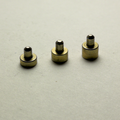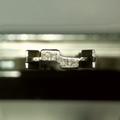IKON WSW: Difference between revisions
m (added images, and text re Bo Widen.) |
m (→Gallery: <div align="center">) |
||
| (7 intermediate revisions by 2 users not shown) | |||
| Line 1: | Line 1: | ||
<span style="font-size:22px">{{PAGENAME}}</span> | <span style="font-size:22px">{{PAGENAME}}</span> | ||
---- | ---- | ||
| Line 8: | Line 10: | ||
|maker = [[IKON]] | |maker = [[IKON]] | ||
|years_produced = | |years_produced = | ||
|ratings = [[EN 1303]] | |||
|patent = | |patent = | ||
|related = | |related = | ||
|spec_on = true | |spec_on = true | ||
|spec_comp = 6 | |spec_comp = 6 pin-tumblers, 5 sliders | ||
|spec_comptype = [[Pin_tumbler|Pin-tumbler]] | |spec_comptype = [[Pin_tumbler|Pin-tumbler]], [[Slider]] | ||
}} | }} | ||
The '''WSW''' is | The '''WSW''' is an [[EN 1303]]-rated [[Pin_tumbler|pin-tumbler]] lock, with a wave-track and [[Dimple |dimple]] key, made by the German company [[IKON]]. | ||
__TOC__ | __TOC__ | ||
| Line 21: | Line 24: | ||
[[Image:IKON WSW components full.jpg|right|thumb|255px|WSW internal components]] | [[Image:IKON WSW components full.jpg|right|thumb|255px|WSW internal components]] | ||
The WSW key is bitted on the sides and edges of the blade and is reversible. The mark of inventor Bo | The WSW key is bitted on the sides and edges of the blade and is reversible. The mark of inventor Bo Widén appears on the key bow. The key has a row of six [[dimple]] cuts along the narrow edge of the blade, matching six pin-tumbler stacks in the cylinder. There are three different heights for these key pins. They are T-shaped and rest in matching chambers drilled in the [[Plug |plug]]. The brass driver pins for this row of pins are a mix of three standard pins and three spool [[security pins]]. | ||
The WSW also features one or two [[sidebar]]s, depending on the model. The interior model has five [[side pin]] | The WSW also features one or two [[sidebar]]s, depending on the model. The interior model has five [[side pin]] sliders with a single sidebar. The exterior model adds either two or five additional side pins connected to a second sidebar. The steel side pins are spring-biased and control the sidebar(s) of the lock. <!-- Each side pin has XXX cuts. --> | ||
To open the lock, all six key | To open the lock, all six key pins must be aligned at the [[shear line]] while all side pins are aligned with the sidebar. ''(See also [[Pin_tumbler#Principles_of_operation|Pin-tumbler, Principles of operation]])'' | ||
== Disassembly instructions == | == Disassembly instructions == | ||
The WSW is disassembled in the | The IKON WSW is disassembled much like other [[Euro Profile|euro profile]] cylinders, with some care for the sidebar and side pins during disassembly. | ||
The WSW has a multiple component [[Actuator |cam piece]] that is disassembled before the plug can be removed. To access the cam components, rotate the cam until a hole in the side of the cam is revealed, and insert a tool to press the spring-biased retainer inside. At the same time, pry away the side plate of the cam. The inner two plates can then be removed, allowing the plug to slide through the cylinder housing. | |||
A [[Plug_follower#Pinning_shoe|pinning shoe]], used with a modified key, is a common method for removing the plug from a Euro profile cylinder. The plug is rotated 180 degrees either clockwise or counter-clockwise, and the pin retainer inserted into the edge of the keyway. This allows the plug to be removed while preventing the driver pins and springs from escaping the cylinder housing. As an alternative method, a [[Plug follower|segmented plug follower]] could be used. | |||
== Ratings == | |||
* [[EN_1303 |EN 1303:2005]] rated 1-6-0-1-0-C-6-23 | |||
== Gallery == | == Gallery == | ||
<gallery align="center"> | <div align="center"><gallery align="center"> | ||
File:IKON_WSW_cylinder_and_key_-_FXE47530.jpg | | File:IKON_WSW_cylinder_and_key_-_FXE47530.jpg | An IKON WSW cylinder and key, with the Bo Widén mark visible on the key bow. | ||
File:IKON WSW pin-tumblers - FXE47988.jpg | Pin-tumblers | File:IKON WSW pin-tumblers - FXE47988.jpg | Pin-tumblers | ||
File:IKON WSW sliders - FXE47984.jpg | Side pins | File:IKON WSW sliders - FXE47984.jpg | Side pins | ||
File:IKON WSW sidebar - FXE47985.jpg | Sidebar | File:IKON WSW sidebar - FXE47985.jpg | Sidebar | ||
File:IKON WSW core top view - FXE47989.jpg | | File:IKON WSW core top view - FXE47989.jpg | An IKON WSW plug, view of the pin chambers. | ||
File:IKON WSW core side view - FXE47996.jpg | | File:IKON WSW core side view - FXE47996.jpg | Sidebar channel. | ||
File:IKON WSW core bottom view - FXE47992.jpg | | File:IKON WSW core bottom view - FXE47992.jpg | A view of the slider chambers in a WSW plug. | ||
File:IKON WSW side pin - FXE47984-Edit.jpg|Side pin | |||
File:Ikon_WSW_finger_pin-Snow.jpg | Side pin | File:Ikon_WSW_finger_pin-Snow.jpg | Side pin | ||
File:IKON_WSW_pins-Reinder.png |Three sizes of key pins | File:IKON_WSW_pins-Reinder.png |Three sizes of key pins | ||
File:IKON_WSW_key_edge-Reinder.jpg |A key for a WSW cylinder. | |||
File:IKON WSW key blade-Reinder.png |A view of the bitting on a WSW key. | File:IKON WSW key blade-Reinder.png |A view of the bitting on a WSW key. | ||
File:IKON WSW key tip profile-Reinder.png |WSW key tip profile. | File:IKON WSW key tip profile-Reinder.png |WSW key tip profile. | ||
</gallery> | </gallery></div> | ||
<br clear="all"> | <br clear="all"> | ||
| Line 68: | Line 78: | ||
[[Category:Dimple locks]] | [[Category:Dimple locks]] | ||
[[Category:Sidebar locks]] | [[Category:Sidebar locks]] | ||
[[Category:Slider locks]] | |||
[[Category:Undercut groove keyways]] | |||
[[Category:EN 1303 locks]] | |||
Latest revision as of 12:30, 3 February 2023
IKON WSW
| IKON WSW | |
 | |
| Name | IKON WSW |
|---|---|
| Manufacturer | IKON |
| Lock Type | Cylinder |
| Lock Design | Pin-tumbler, Sidebar |
| Security Rating(s) | EN 1303 |
| Specifications | |
| # of Components | 6 pin-tumblers, 5 sliders |
| Component Type | Pin-tumbler, Slider |
The WSW is an EN 1303-rated pin-tumbler lock, with a wave-track and dimple key, made by the German company IKON.
Principles of operation
The WSW key is bitted on the sides and edges of the blade and is reversible. The mark of inventor Bo Widén appears on the key bow. The key has a row of six dimple cuts along the narrow edge of the blade, matching six pin-tumbler stacks in the cylinder. There are three different heights for these key pins. They are T-shaped and rest in matching chambers drilled in the plug. The brass driver pins for this row of pins are a mix of three standard pins and three spool security pins.
The WSW also features one or two sidebars, depending on the model. The interior model has five side pin sliders with a single sidebar. The exterior model adds either two or five additional side pins connected to a second sidebar. The steel side pins are spring-biased and control the sidebar(s) of the lock.
To open the lock, all six key pins must be aligned at the shear line while all side pins are aligned with the sidebar. (See also Pin-tumbler, Principles of operation)
Disassembly instructions
The IKON WSW is disassembled much like other euro profile cylinders, with some care for the sidebar and side pins during disassembly.
The WSW has a multiple component cam piece that is disassembled before the plug can be removed. To access the cam components, rotate the cam until a hole in the side of the cam is revealed, and insert a tool to press the spring-biased retainer inside. At the same time, pry away the side plate of the cam. The inner two plates can then be removed, allowing the plug to slide through the cylinder housing.
A pinning shoe, used with a modified key, is a common method for removing the plug from a Euro profile cylinder. The plug is rotated 180 degrees either clockwise or counter-clockwise, and the pin retainer inserted into the edge of the keyway. This allows the plug to be removed while preventing the driver pins and springs from escaping the cylinder housing. As an alternative method, a segmented plug follower could be used.
Ratings
- EN 1303:2005 rated 1-6-0-1-0-C-6-23
Gallery
See also
| This article is a stub. You can help Lockwiki by expanding it. |














